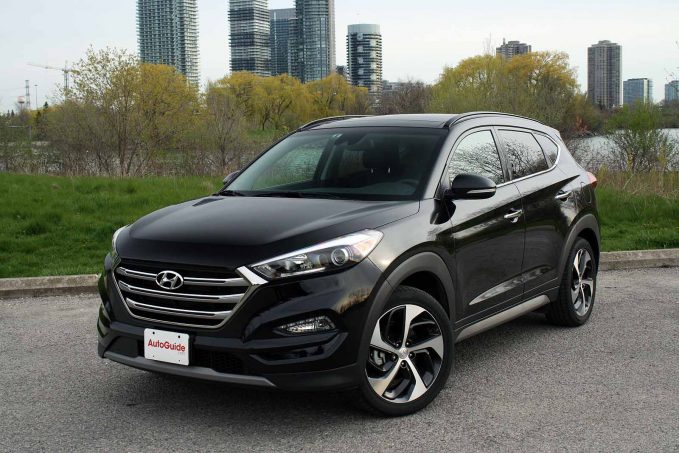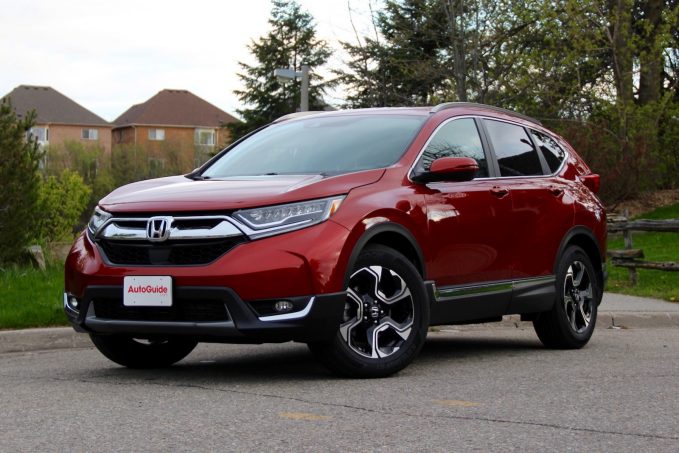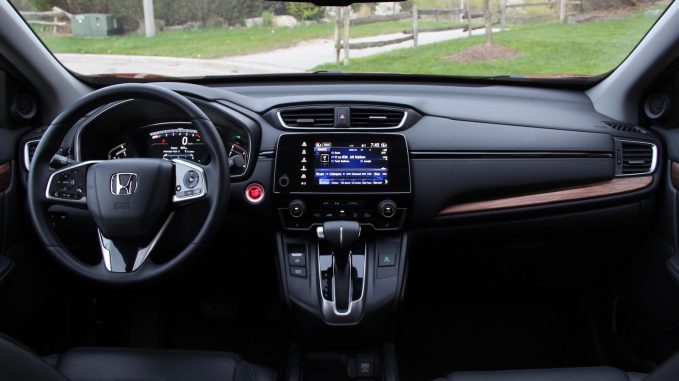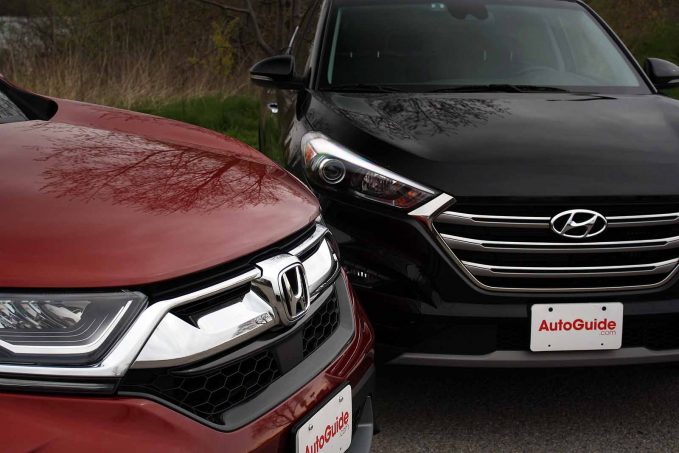The Honda CR-V has pretty much always been the benchmark when it comes to compact crossovers and that means it has always been the one to beat.
It has beat everything AutoAfterWorld.com has compared it with so far: The Ford Escape, Toyota RAV4, Mazda CX-5, and the Subaru Forester, which are all fantastic crossovers, so the fact that the Honda beat them all is nothing short of impressive.
The Hyundai Tucson has always been one of my personal favorite cars in this segment and it’s a solid competitor, but is it good enough to beat the newer CR-V? Hyundai is always benchmarking Honda, but we wanted to see if it goes above and beyond what Honda is offering.
Get the Flash Player to see this player.
Style and Substance
Style is totally a personal preference, but we’re not the first to say that the new CR-V’s design has a bit too much going on to make it truly attractive. The Tucson has cleaner lines and is a bit more traditional without being boring, which means the design will age a bit better. It also has a more planted look, which also translates into how it drives.
The Tucson has a suspension setup that’s a middle ground between the CR-V’s softer ride and the Ford Escape’s harsher sportier ride. It’s comfortable, predictable, and rides smoothly over rough roads while still not feeling terrible in corners. It feels a lot more buttoned-down and composed than the CR-V, which can feel sloppy at times.
This Tucson is powered by a 1.6-liter turbo four-cylinder, which is the better choice over the naturally aspirated 2.0-liter base engine. With 175 horsepower and 195 pound-feet of torque, it has more torque but less horsepower than the CR-V. The torque difference is pretty obvious because the Hyundai accelerates a touch faster off-the-line and when passing on the highway.
The CR-V has a 1.5L turbo with 190 hp and 179 lb-ft of torque. In terms of driving dynamics, both are pretty similar, there are no big surprises — both are predictable, not overly exciting, and very easy to drive and maneuver, which is what really matters. Acceleration for both aren’t going to blow you away, but they’re both totally acceptable and get you where you’re going.
ALSO SEE: 2017 Honda CR-V vs Toyota RAV4
The Hyundai’s seven-speed dual clutch transmission can be wonky and easy to confuse, especially during low-speed driving like when you’re creeping forward in traffic. It judders a lot of seems like it has trouble finding the right gear sometimes. The CR-V has a CVT and it’s whiny and somewhat unresponsive, so I’m more willing to forgive the Tucson’s transmission because it’s just easier to live with.
Fuel Economy
The Tucson, however, lags behind the CR-V in all areas in terms of fuel economy: highway, city, and observed, so if better mileage is what you want, go for the Honda. The Tucson is rated to get 24 mpg in the city, 28 on the highway, and 25 combined (9.9/8.5/9.3 L/100 km). During our testing, we were hovering around 21 mpg, but we were driving it pretty aggressively and almost exclusively in the city.
The CR-V is rated at 27 in the city, 33 on the highway and 29 combined (8.7/7.2/8.0 L/100 km). We got between 26 and 30 in real-world testing, and all those numbers beat what the Hyundai gets. It’s also slightly lighter, which helps a bit.
Compare Specs
Interior Tech and Practicality
Although the Tucson has worse fuel economy, its infotainment system is much better than the CR-V’s. It’s more user-friendly, easier to navigate, it’s faster and more responsive. That doesn’t mean that Honda’s system is awful, there are just little things here and there that make Hyundai’s system better.
ALSO SEE: 2017 Honda CR-V vs 2017 Ford Escape
But in general, Honda did a much better job with the interior design. It looks a lot more modern than the Hyundai and is more visually interesting. Honda’s interior has a bit more design flourish, with the silver accents and this faux wood grain trim. The dashboard has a clean, simple design with not a lot of buttons. I also like that the gauge cluster is almost fully digital, where the Hyundai’s is mostly analog.

The Tucson’s interior is perfectly functional, but it’s not as interesting to look at, and even though it has more buttons, it still doesn’t look too busy. I do prefer the Tucson’s shifter better because it feels higher quality, where the CR-V’s feels clunky to use.
I like that the CR-V has more useful cubbies and an electronic parking brake rather than the floor pedal-operated one on the Tucson. Again, there’s nothing inherently wrong with either cabin and both are very user-friendly. The Honda also has slightly less headroom front and back, but more legroom in the back than the Tucson.
ALSO SEE: 2017 Honda CR-V vs 2017 Subaru Forester
Chances are, if you’re looking for a car in this segment, you care more about cargo capacity than driving dynamics, and once again, the CR-V beats the Hyundai with superior space. With all the seats up, the CR-V gets 39.2 cubic feet (1,110 L) of space. Putting the rear seat flat opens up 75.8 cubic feet (2,146 L). Moving over to the Tucson, it has 31 cubic feet (878 L) and 61.9 (1,753 L) with the seats down, which is a huge disadvantage.
Features
These two crossovers are pretty different in terms of what kind of features they have. The CR-V has memory seats, more USB ports and fast charging ones too, adaptive cruise, and lane-keep assist with active steering, which the Tucson doesn’t have. I’m OK to let that slide because I barely use adaptive cruise because the CR-V’s still doesn’t feel natural enough, and lane-keep assist is usually too aggressive with the steering corrections and incessant beeping, so I don’t use it either.
The Tucson gets ventilated seats, a better backup camera, rear parking sensors, adaptive headlights, a locking differential, and hill descent control. These are all things that the CR-V doesn’t have, so I’d argue that it is better equipped. If the Tucson had the adaptive cruise and fast charging USB ports, it would be a clearer win.
ALSO SEE: 2017 Mazda CX-5 vs 2017 Honda CR-V
They both have cross-traffic alert, automatic emergency braking and front collision alert (I like Hyundai’s better because it’s less aggressive), blind spot monitoring, heated rear seats and hands-free tailgates.
The fact that the Tucson is better equipped is really interesting because the starting and as-tested price undercut the CR-V by a few hundred dollars. That’s not a huge difference, but getting more stuff for less money seems like a deal to me.
The Verdict: 2017 Honda CR-V vs Hyundai Tucson
I love that the Tucson drives better, has more equipment for less money, a better infotainment system, and is just better looking. I think the wonky dual clutch transmission could be smoothed out, and it’s not as fuel efficient and doesn’t have as much cargo capacity as the Honda.
The Honda, on the other hand, seems much more practical with a bigger cargo area. It’s more fuel efficient, has a stylish interior, and is the sales leader for good reason. The downsides are that it’s slightly more expensive, the CVT is whiny and slow, and the exterior style is pretty polarizing.
This w
as a really tough comparison to pick a winner for because they’re both just so good at their jobs. Honda has won every single comparison we did so far, but the Tucson is just so good that this time, if it were my money on the line, I’d pick the Tucson, but it wins by a very small margin.
I really like that the Tucson just feels like a better all-round package. It feels more buttoned down when you drive it, the quality is unmistakable, and I think it would be easier to live with. Add in the fact that you get more features for less money, and you really can’t go wrong.
Honda CR-V
Hyundai Tucson












